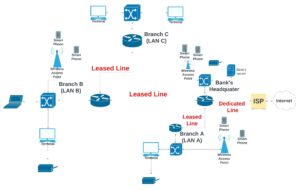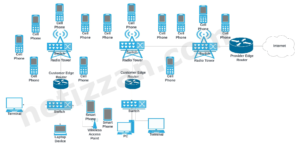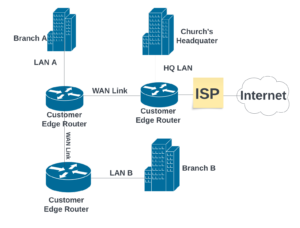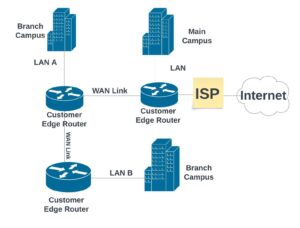Wide Area Network (WAN) is often confused with other network coverages, such as Local Area networks (LAN) and Metropolitan Area networks (MAN), as well as the internet. To fully grasp the differences, we need to examine examples and the underlying network architecture.
In simple terms, a Wide Area Network (WAN) interconnects different branches (LANs) of an organization that are geographically dispersed within a city, state, or even country.
In this article, we will present four user-friendly examples of Wide Area Networks (WANs) along with their network diagrams.
Here is a video tutorial on architecture of WAN;
Examples of Wide Area Networks
A wide area network is network used for enterprises having multiple branches across a state or a country.
Here are four familiar examples of Wide area network
- Banks Networks
- Mobile Network
- Big Church’s Network
- School Network (School with Multiple Campuses)
Each of these examples shares the same WAN network architecture, but for clarity, we will showcase the network diagram for each one.
1) Banks Network
Bank enterprises often have multiple branches distributed across a country. These branches need to interconnect and use the same database to access user data for seamless transaction processing. To achieve this, banks rely on their Wide Area Network (WAN) to ensure fast and secure transactions.
In the architecture below, we present a bank with its headquarters connected to an Internet Service Provider (ISP) via a dedicated line. The connectivity is then extended to Branch A, Branch B, and Branch C using leased lines. At each branch, there is a router serving as the gateway for that specific Local Area Network (LAN). These routers facilitate multiple user equipment connections through switches.
As depicted below, the bank’s database is attached to the router at the headquarters, and all other branches utilize this centralized database. This centralized approach ensures consistent and efficient data access for all branches.

2) Mobile Network
Much like how banks utilize a Wide Area Network (WAN) to interconnect their branches, a mobile network’s architecture is also an example of a WAN.
In the mobile network architecture diagram showcased below, we begin with a cloud symbol on the right side of the diagram, signifying the internet.

The Provider Edge Router, which is attached to the cloud symbol, serves as the central gateway connecting the mobile network to the provider’s core network. This connection enables communication between the mobile base stations (towers) and the wider network infrastructure.
Three mobile base stations (towers) are placed in succession, and a switch beneath them aggregates their traffic. These switches, serving as intermediate network devices, ensure efficient data transfer from the towers to the Provider Edge Router.
The mobile devices (representing user equipment) are situated next to the towers, reflecting their wireless connectivity to the mobile network.
To connect remote customer locations to the mobile network, Customer Edge Routers (CE Routers) come into play, much like how branches in the bank network are connected via leased lines.
This mobile network architecture demonstrates a true example of a Wide Area Network (WAN) by connecting geographically dispersed mobile base stations and customer locations to a central gateway (Provider Edge Router).
3) Church’s Network
Churches with multiple branches can greatly benefit from utilizing a Wide Area Network (WAN), especially when they need to access and utilize a centralized database across all their branches. Implementing a WAN enables seamless and secure communication between the different branches, facilitating faster data exchange.
In the WAN architecture depicted below for churches, the main branch acquires internet connectivity from an Internet Service Provider (ISP). This internet connection is then extended to Branch A and Branch B through dedicated WAN links.

4) School’s Network
A school with multiple campuses is also a perfect establishment that can use a wide-area network. In this case, the school’s main campus will need to obtain internet from the closest or preferred ISP using a dedicated line and then utilize a leased line to extend this connectivity to other branches.
The architecture of School’s wide area network is just like that of Church’s Wide Area network. You can observe this from the topology below:

FAQs
Is internet a WAN or LAN?
The Internet is not a Wide Area Network (WAN) or a Local Area Network (LAN). It’s a global network that interconnects various types of networks, including WANs and LANs, as well as individual devices.
Conclusion
Wide-area networks are networks that interconnect enterprises with branches that are geographically dispersed. It is a network that joins the LANs of each of those branches. Examples of LANs include a bank’s network, a mobile network, a church’s network, and a school’s network.
With the architecture of these networks that we have showcased above, we believe you fully understand what WAN is and its examples.

I am a passionate Networking Associate specializing in Telecommunications.
With a degree in Electronic engineering, I possess a strong understanding of electronic systems and the intricacies of telecommunications networks. I gained practical experience and valuable insights working for a prominent telecommunications company.
Additionally, I hold certifications in networking, which have solidified my expertise in network architecture, protocols, and optimization.
Through my writing skills, I aim to provide accurate and valuable knowledge in the networking field.
Connect with me on social media using the links below for more insights.
You can contact me using [email protected] or connect with me using any of the social media account linked below



